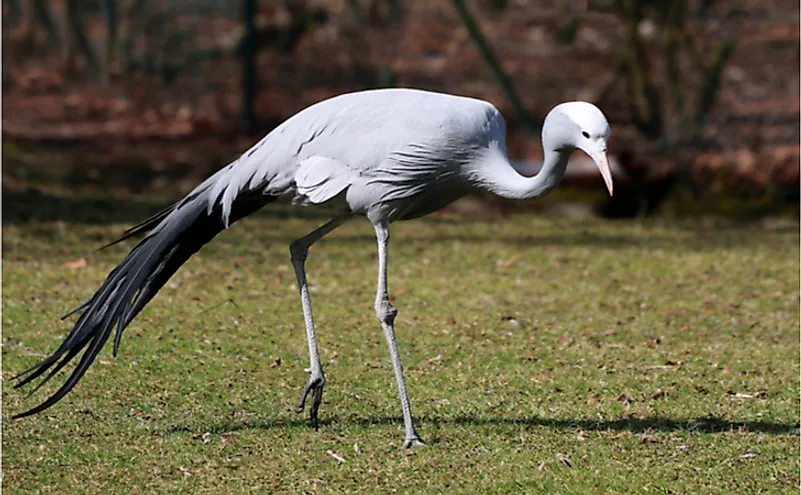Blue Crane, The National Bird Of South Africa

The blue crane (Grus paradisea) is native to Southern Africa and is the national bird of South Africa. The bird is relatively tall but smaller than other members of the Crane family. The blue crane stands about 3.5 inches and has an average wingspan of 6 ft 4 in. They have a pale grey plumage that is darkest on the tertial plumes and lightest on the head. Juveniles resemble adults except for the tertial plumes. They often fly in a V-formation and can reach speeds of up to 50 mph.
Distribution And Habitat
The blue crane is native to South Africa. It has a limited range with robust populations in Eastern Cape, Western Cape, southern Mpumalanga, and the Western regions of KwaZulu-Natal. Smaller populations are found in northern Namibia, Botswana, and Zimbabwe. The Eastern Cape population has declined over the years and has become extinct in some breeding sites, while the Western Cape population has risen slightly during the last few decades. The blue crane prefers upland habitats, especially open grasslands. They are mostly found in the wilderness but can inhabit croplands and cultivated pastures. They also feed and roost in shallow wetlands. In the arid areas of Namibia and the Karoo, they inhabit the dry grassland and dwarf shrublands that receive an average of about 300 mm rainfall per year.
What Do Blue Cranes Eat?
Blue cranes are omnivorous, but their diet is dominantly plant-based. They feed on small roots and seeds, bulbs, and fruits. They occasionally feed on insects, small reptiles, crustaceans, small mammals, and fish. They flock cultivated lands during the harvesting season to feed on fallen maize and wheat.
Breeding
The blue crane is highly seasonal when it comes to breeding. Eggs are mostly recorded between October and March. In early October, potential parents begin looking for mating partners within the flock. Males engage in a dance competition and fling objects into the air to entice the females. Most nests have two eggs, while a few have one or three. Males incubate the eggs at night while females incubate during the day, as the males defend the nest and find food. The incubation period is about 30 days. Chicks are capable of walking after two days and can swim after a week. They fly after 3-5 months and stay with their parents until the next breeding season.
Communication
Blue cranes communicate by making noisy calls, especially when in a flock. During the mating season, both males and females engage in a duet dance of leaping into the air, taking short runs, and tossing small animals and bits of grass into the air. Chicks make soft peeping sounds until they are at least a year old.
Behavior
Blue cranes are partially social but become solitary or pair up during the breeding season. Flocks have a strict hierarchy, with large adult males establishing dominance. They are aggressive towards other blue cranes in their territories but are more accommodating to other cranes, such as the large warder. They become relentlessly aggressive in the nesting season and can attack non-predatory animals such as sparrows, plovers, tortoises, and cattle.
Interaction With Humans
The blue crane is the national bird of South Africa and is featured in the country's coins and stamps. It is also common in parks and zoos. Bird enthusiasts from across the world visit South Africa to experience the blue crane in its natural environment. It is of cultural importance to the amaXhosa tribe, which presented the feathers of the bird to men who committed deeds of valor.
Conservation Status Of Blue Cranes
The global population of blue cranes has declined due to habitat loss, powerline collision, and poisoning by farmers. The species is listed as vulnerable. Large populations were found in the Free State before the 1990s when their numbers began declining. Threats to their habitat include deforestation, growing human populations, urbanization, and infrastructural development. Farmers kill the birds by poisoning due to its propensity to forage in agricultural fields. In 2015, a farmer intentionally killed over 200 blue cranes by poisoning. As of 2019, the global population was estimated at 25,000 birds, half of which are in Cape Overberg. The government of South Africa has enacted laws to protect the species from poaching and poisoning, in addition to educating the public on the importance of the birds and protecting their natural habitats.











